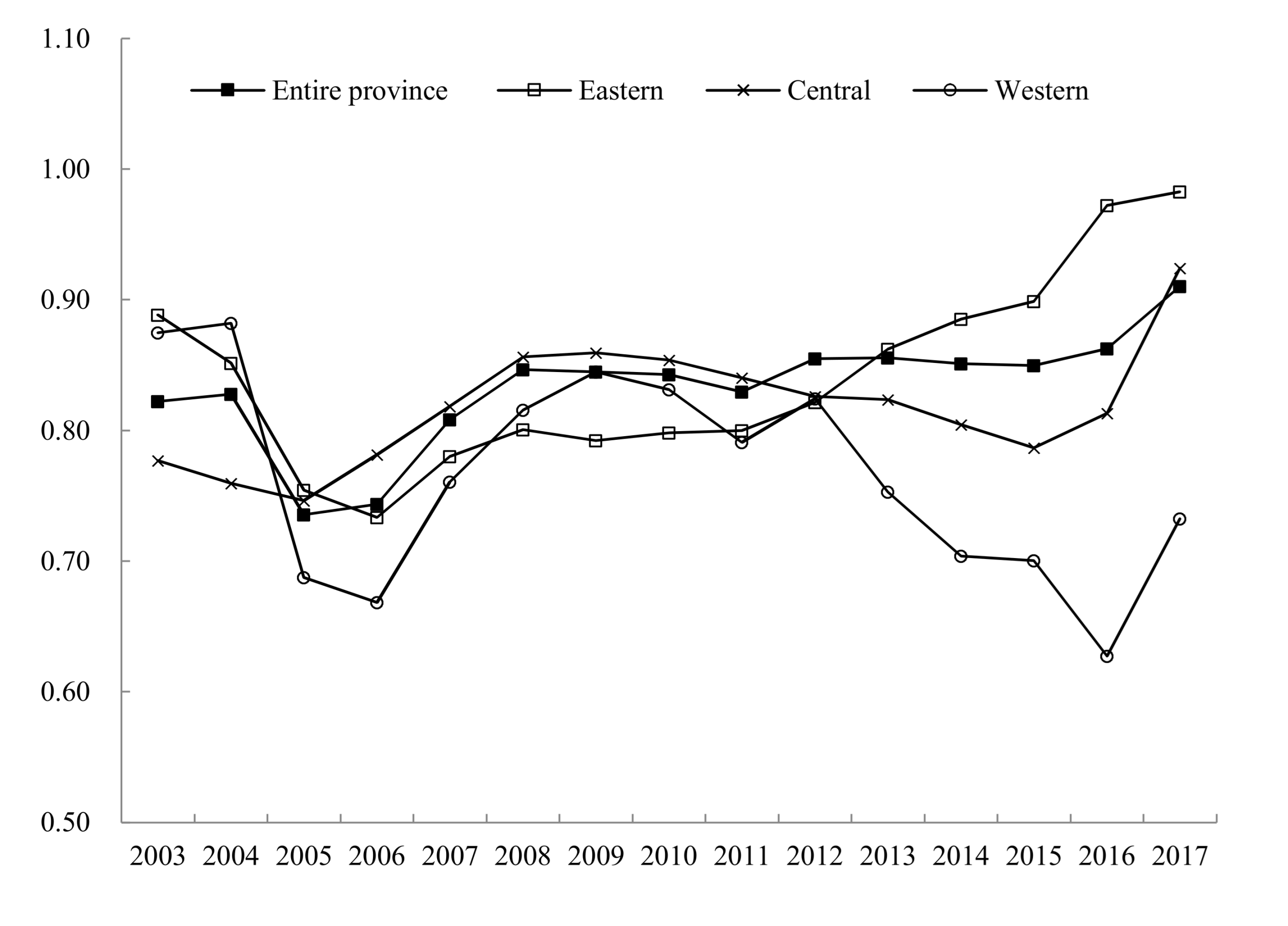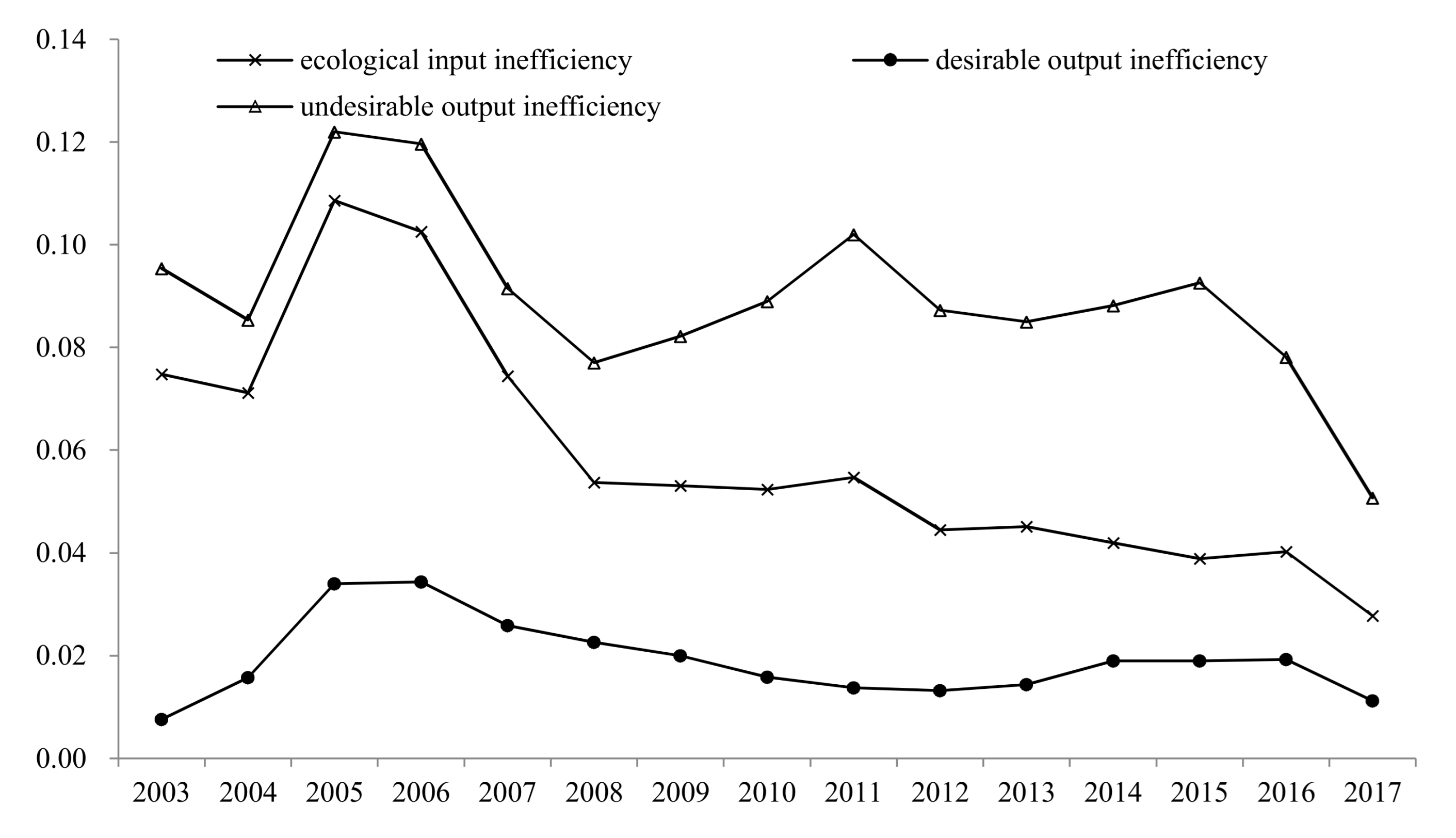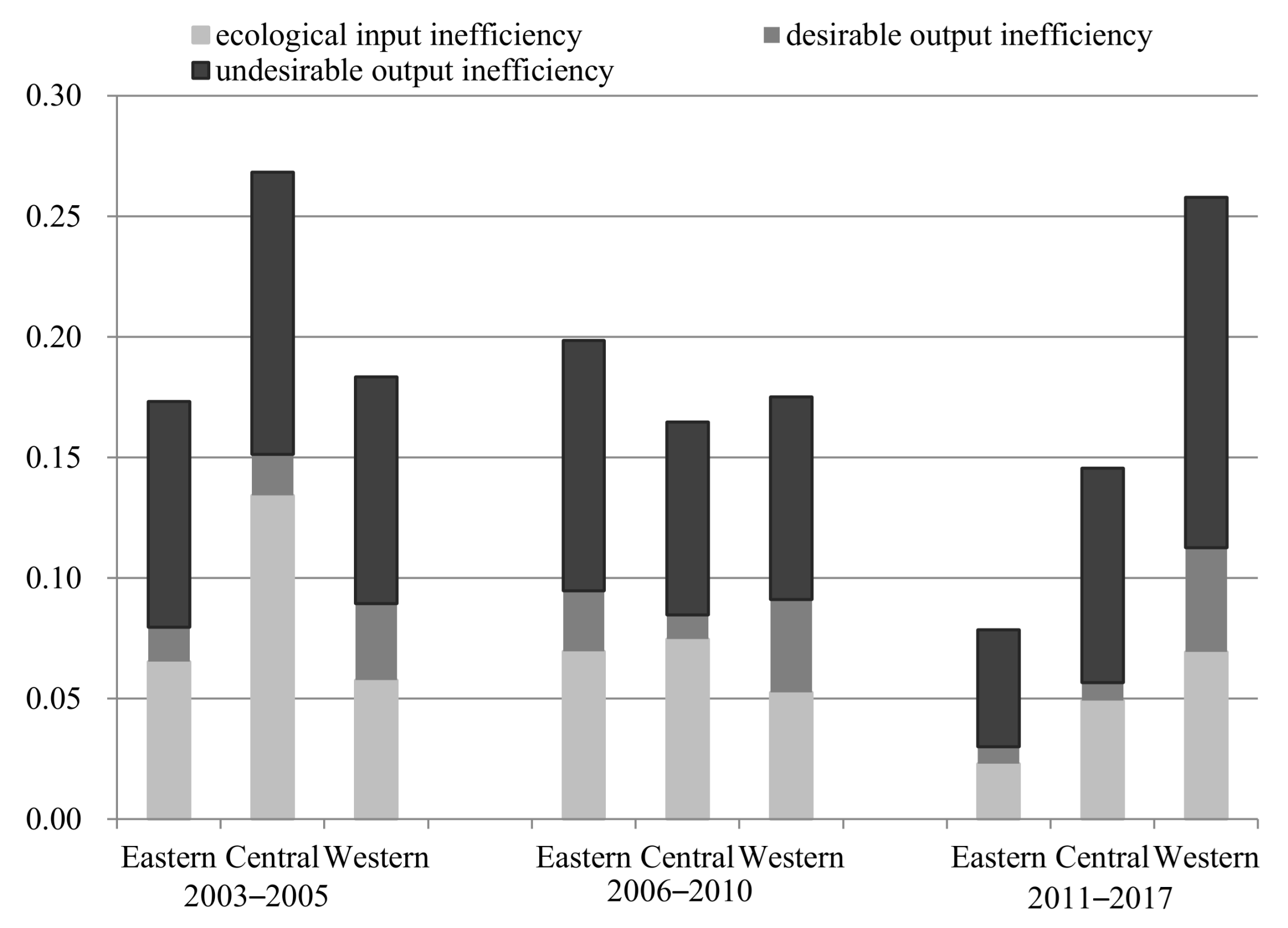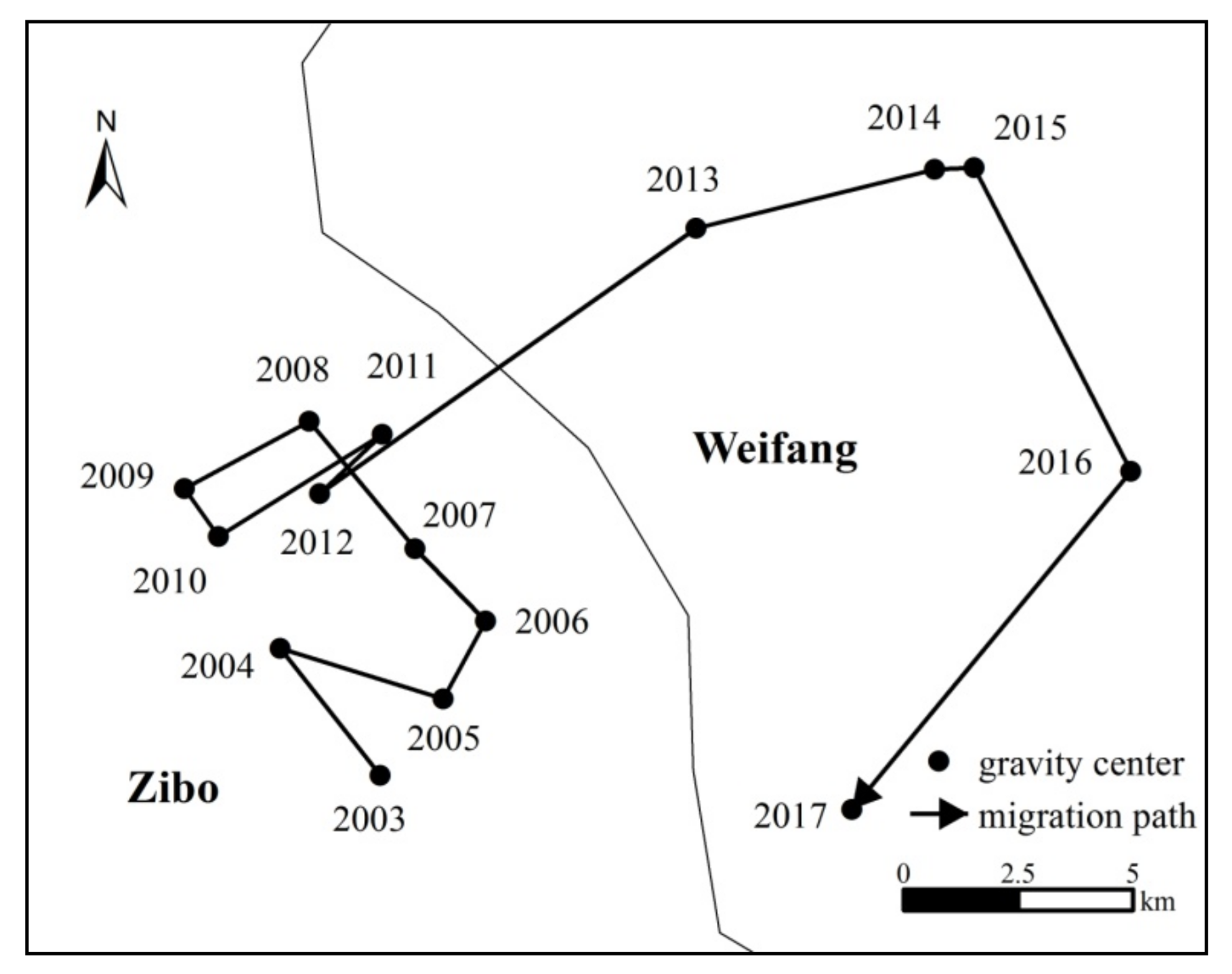Eco-Province Construction Performance and Its Influencing Factors of Shandong Province in China: From Regional Eco-Efficiency Perspective
Abstract
:1. Introduction
2. Materials, Methodologies and Data Description
2.1. Study Area
2.2. Methods
2.2.1. SBM Directional Distance Function
2.2.2. Theil Index and Decomposition
2.2.3. Gravity-Center Migration Model
2.2.4. Hot-Spot Analysis (Getis-Ord Gi*)
2.2.5. Tobit Model
2.3. Variables and Data Description
2.3.1. Inputs and Outputs
2.3.2. Influencing Factors
2.3.3. Data Description
3. Results and Analysis
3.1. Temporal Evolutionary Characteristics of Shandong’s EPC Performance
3.2. Spatial Evolutionary Characteristics of Shandong’s EPC Performance
3.3. Influencing Factors of Shandong’s EPC Performance
4. Discussion
5. Conclusions and Policy Implications
Author Contributions
Funding
Institutional Review Board Statement
Informed Consent Statement
Data Availability Statement
Conflicts of Interest
References
- World Commission on Environment and Development (WCED). Our Common Future; Oxford University Press: New York, NY, USA, 1987; p. 8. [Google Scholar]
- Wang, Y.; Ding, Q.; Zhuang, D. An eco-city evaluation method based on spatial analysis technology: A case study of Jiangsu Province, China. Ecol. Indic. 2015, 58, 37–46. [Google Scholar] [CrossRef]
- Register, R. Eco-City Berkeley: Building Cities for a Healthy Future; North Atlantic Books: Berkeley, CA, USA, 1987; pp. 13–43. [Google Scholar]
- Shwayri, S.T. A Model Korean Ubiquitous Eco-City? The Politics of Making Songdo. J. Urban Technol. 2013, 20, 39–55. [Google Scholar] [CrossRef]
- Cugurullo, F. Urban eco-modernisation and the policy context of new eco-city projects: Where Masdar City fails and why. Urban Stud. 2016, 53, 2417–2433. [Google Scholar] [CrossRef]
- Li, Y.; Qiu, L. A comparative study on the quality of china’s eco-city: Suzhou vs Kitakyushu. Habitat. Int. 2015, 50, 57–64. [Google Scholar] [CrossRef]
- Yin, Y.; Olsson, A.; Hakansson, M. The role of local governance and environmental policy integration in swedish and chi-nese eco-city development. J. Clean. Prod. 2016, 134, 78–86. [Google Scholar] [CrossRef]
- Li, Y.; Commenges, H.; Bordignon, F.; Bonhomme, C.; Deroubaix, J.-F. The Tianjin Eco-City model in the academic literature on urban sustainability. J. Clean. Prod. 2019, 213, 59–74. [Google Scholar] [CrossRef] [Green Version]
- Xie, Z. Building Eco-Province with Scientific Development Sight. Environ. Prot. 2004, 2, 3–6. [Google Scholar]
- Zhu, G. Ecological province construction is a profitable probe and practice of regional sustainable development. Chin. J. Eco Agric. 2004, 12, 8–11. [Google Scholar]
- Wang, Y.; Sun, M.; Wang, R.; Lou, F. Promoting regional sustainability by eco-province construction in China: A critical assessment. Ecol. Indic. 2015, 51, 127–138. [Google Scholar] [CrossRef]
- Huang, Q.; Zeng, Y.; Jiang, Q. Progress and prospect of the study on “making great efforts to promote ecological civilization construction”. China Popul. Resour. Environ. 2015, 25, 111–120. [Google Scholar]
- Mi, Z.; Zeng, G.; Shang, Y.; Chen, S.; Zhu, F. The evaluation method and spatial pattern evolution of ecological civilization construction of chinese provinces. Econ. Geogr. 2016, 36, 15–21. [Google Scholar]
- Shen, M. Germination and sublimation of Xi Jinping’s ecological civilization thought. China Popul. Resour. Environ. 2018, 28, 1–7. [Google Scholar]
- Li, W. Sustainable development and eco-province construction. Impact Sci. Soc. 2004, 1, 14–21. [Google Scholar]
- SEPA. Guidelines on Building Eco-Province, Eco-City and Eco-County (Revised Version). Available online: www.mee.gov.cn (accessed on 18 October 2021).
- Wang, Y.; Shang, J. Application of ecological footprint analysis method to quantitative assessment of sustainable development—A case study of jilin in 2002. J. Arid Land Resour. Environ. 2006, 20, 146–150. [Google Scholar]
- Fu, G. Quantitative study of ecological sustainable development in Hainan ecological province: Application of ecological footprint method. Res. Agric. Mod. 2006, 27, 11–16. [Google Scholar]
- Tan, J.; Tang, M. The theory of ecological footprint and the eco-province construction of Jiangsu. J. Nanjing Norm. Univ. 2006, 29, 121–126. [Google Scholar]
- Sui, L.; Zhao, Z.; Jin, Y.; Guan, X.; Xiao, M. Dynamic evaluation of natural ecosystem service in Hainan Island. Resour. Sci. 2012, 34, 572–580. [Google Scholar]
- Li, G.; Yan, P.; Yuan, A. Study on the evaluation index system of ecological Shandong. Ecol. Econ. 2015, 31, 185–191. [Google Scholar]
- Yan, H.; Cao, Y.; Yu, Z. Quantitative analysis and evaluation of ecological construction of Heilongjiang province. J. Northeast For. Univ. 2008, 36, 76–77. [Google Scholar]
- Tian, S. Assessment on eco-province construction level in China. J. Arid Land Resour. Environ. 2017, 31, 14–20. [Google Scholar]
- Chu, Z.; Chen, W. Fuzzy synthesis evaluation of ecological construction in Heilongjiang province. J. Arid Land Resour. Environ. 2008, 22, 37–41. [Google Scholar]
- OECD. Eco-efficiency. Organization for Economic Co-operation and Development, Paris, 1998. Available online: https://www.oecd.org/officialdocuments/publicdisplaydocumentpdf/?cote=ENV/EPOC/PPC/T(98)5&docLanguage=En (accessed on 18 October 2021).
- Kuosmanen, T.; Kortelainen, M. Measuring Eco-efficiency of Production with Data Envelopment Analysis. J. Ind. Ecol. 2005, 9, 59–72. [Google Scholar] [CrossRef]
- Mickwitz, P.; Melanen, M.; Rosenström, U.; Seppälä, J. Regional eco-efficiency indicators—A participatory approach. J. Clean. Prod. 2006, 14, 1603–1611. [Google Scholar] [CrossRef]
- Yin, K.; Wang, R.; An, Q.; Yao, L.; Liang, J. Using eco-efficiency as an indicator for sustainable urban development: A case study of chinese provincial capital cities. Ecol. Indic. 2014, 36, 665–671. [Google Scholar] [CrossRef]
- Gusmao Caiado, R.G.; Dias, R.D.F.; Mattos, L.V.; Goncalves Quelhas, O.L.; Leal Filho, W. Towards sustainable development through the perspective of eco-efficiency-a systematic literature review. J. Clean. Prod. 2017, 165, 890–904. [Google Scholar] [CrossRef] [Green Version]
- Hu, Y.; Peng, J.; Liu, Y.; Wang, M.; Wang, Y. Review on regional eco-efficiency research. Sheng Tai Xue Bao 2018, 38, 8277–8284. [Google Scholar]
- Yang, L.; Ma, C.; Yang, Y.; Zhang, E.; Lv, H. Estimating the regional eco-efficiency in China based on bootstrapping by-production technologies. J. Clean. Prod. 2020, 243, 118550.1–118550.13. [Google Scholar] [CrossRef]
- Ding, P.; Tian, L.; Chen, B. Material Flow Characteristics and Evolution of Environmental-economic System in Hainan Province from 1990 to 2008. China Popul. Resour. Environ. 2011, 21, 66–71. [Google Scholar]
- Liu, B.; Li, L.; Xu, X. Research on regional eco-efficiency evaluation of Shandong province based on DEA cross-evaluation. East China Econo. Manag. 2010, 24, 38–41. [Google Scholar]
- Chen, X.; Sun, L. Differences of regional eco-efficiency based on super efficiency DEA model in Shandong province. J. Bohai Univ. 2015, 36, 90–96. [Google Scholar]
- Cai, J.; Xia, X.; Li, S. Regional eco-efficiency under the perspective of new urbanization according to panel data for 17 cities in Shandong. Resour. Sci. 2015, 37, 2271–2278. [Google Scholar]
- Zhou, Y.; Zong, K.; Hou, S. Regional eco-efficiency evaluation and spatial correlation analysis-a case study of Shandong. Acad. Forum 2016, 39, 78–81. [Google Scholar]
- WBCSD. Eco-Efficiency: Creating More Value with Less Impact. Available online: www.wbcsd.org (accessed on 18 October 2021).
- Guo, F.; Lv, X.; Yu, W.; Ren, J.; Chu, N. Performance evaluation and driving mechanism of green development in Shandong Province based on panel data of 17 cities. Sci. Geol. Sin. 2020, 40, 200–210. [Google Scholar]
- Andrés, J.; Mercedes, B.; José, A. Assessing eco-efficiency with directional distance functions. Eur. J. Oper. Res. 2012, 220, 798–809. [Google Scholar]
- Fukuyama, H.; Weber, W. A directional slacks-based measure of technical in efficiency. Socio Econ. Plan. Sci. 2009, 43, 274–287. [Google Scholar] [CrossRef]
- Wang, B.; Wu, Y.; Yan, P. Environmental Efficiency and Environmental Total Factor Productivity Growth in China’s Regional Economies. Eco. Res. J. 2010, 5, 95–109. [Google Scholar]
- Zhang, X.; Kanbur, R. What difference do polarisation measures make? An application to China. J. Dev. Stud. 2001, 37, 85–98. [Google Scholar]
- Mu, X.; Lei, L. A research on the economic center evolution and regional development equilibrium of northeast china. Econ. Geogr. 2011, 31, 366–370. [Google Scholar]
- Gao, J.; Xie, W.; Han, Y.; Zhang, Y.; Chen, J. The evolutionary trend and the coupling relation of gravity center moving of county-level population distribution, economical development and grain production during 1990–2013 in Henan province. Sci. Geol. Sin. 2018, 38, 919–926. [Google Scholar]
- Chen, W.; Li, J.; Zeng, J.; Ran, D.; Yang, B. Spatial heterogeneity and formation mechanism of eco-environmental effect of land use change in China. Geogr. Res. 2019, 38, 2173–2187. [Google Scholar]
- Song, M.; Song, Y.; An, Q.; Yu, H. Review of environmental efficiency and its influencing factors in China: 1998–2009. Renew. Sust. Energ. Rev. 2013, 20, 8–14. [Google Scholar] [CrossRef]
- Lv, W.; Hong, X.; Fang, K. Chinese regional energy efficiency change and its determinants analysis: Malmquist index and Tobit model. Ann. Oper. Res. 2015, 228, 9–22. [Google Scholar] [CrossRef]
- Feng, C.; Wang, M.; Liu, G.; Huang, J. Green development performance and its influencing factors: A global perspective. J. Clean. Prod. 2017, 144, 323–333. [Google Scholar] [CrossRef]
- Shan, H. Reestimating the Capital Stock of China: 1952–2006. J. Quant. Technol. Econ. 2008, 10, 17–31. [Google Scholar]
- Luo, N.; Li, J.; Luo, F. Empirical Analysis on the relationship between the China urbanization and regional eco-efficiency. China Popul. Resour. Environ. 2013, 23, 53–60. [Google Scholar]
- Li, S.; Chu, S.; Shen, C. Local government competition, environmental regulation and regional eco-efficiency. J. World Econ. 2014, 4, 88–110. [Google Scholar]
- Cai, F. Preventing the Inverse Kuznets effects of industry structure. Money China 2015, 4, 26–29. [Google Scholar]
- Wu, Y.; Feng, K.; Zeng, Z.; Xiang, G. Dynamic evolution, spatial spillover of FDI and regional eco-efficiency-a case study of Anhui province. East China Econo. Manag. 2017, 31, 16–24. [Google Scholar]
- Zhou, C.; Shi, C.; Wang, S.; Zhang, G. Estimation of eco-efficiency and its influencing factors in Guangdong province based on super-SBM and panel regression models. Ecol. Indic. 2018, 86, 67–80. [Google Scholar] [CrossRef]








| Category | Variable | Unit | Observations | Max | Min | Mean | Std.dev |
|---|---|---|---|---|---|---|---|
| Non-ecological inputs | labor | 10,000 persons | 255 | 723 | 71 | 339 | 158 |
| capital | 100 million yuan | 255 | 26,972 | 301 | 5071 | 4469 | |
| Ecological inputs | land | 1 square kilometers | 255 | 520 | 34 | 143 | 93 |
| water | 1000 tons | 255 | 1126 | 11 | 193 | 142 | |
| energy | 100 million KWH | 255 | 47,394 | 2115 | 12,888 | 10,308 | |
| Desired outputs | GDP | 100 million yuan | 255 | 8612 | 170 | 2125 | 1587 |
| Undesired outputs | wastewater | 1000 tons | 255 | 56,732 | 4220 | 23,915 | 11,887 |
| SO2 | 1 ton | 255 | 233,789 | 15,541 | 94,944 | 41,022 | |
| solid waste | 1000 tons | 255 | 5078 | 64 | 908 | 688 |
| Influencing Factors | Abbreviation | Observations | Max | Min | Mean | Std.dev |
|---|---|---|---|---|---|---|
| Economic development level | pgdp | 255 | 12.0132 | 8.1069 | 10.4039 | 0.7365 |
| Industrial structure | indus | 255 | 60.3 | 13.6 | 36.1806 | 8.1404 |
| Urbanization | urban | 255 | 72.57 | 17.0843 | 44.5354 | 14.4954 |
| Openness | fdi | 255 | 17.7719 | 0.1328 | 1.9889 | 2.3252 |
| Technological innovation | r&d | 255 | 6.4344 | 0.1295 | 2.8783 | 1.7363 |
| Environmental regulation | regu | 255 | 98.94254 | 0.1 | 81.7164 | 20.1853 |
| Influencing Factors | Entire Province | Eastern Region | Central Region | Western Region |
|---|---|---|---|---|
| pgdp | −3.2057 *** | −1.1244 | −4.6894 *** | −1.4401 ** |
| (−6.23) | (−1.20) | (−6.25) | (−2.55) | |
| spgdp | 0.1718 *** | 0.0750 * | 0.2415 *** | 0.0773 *** |
| (6.84) | (1.76) | (6.43) | (2.82) | |
| indus | 0.0013 | 0.0090 * | −0.0108 *** | 0.0113 |
| (0.28) | (1.67) | (−3.7) | (1.14) | |
| urban | −0.0095 *** | −0.0025 | −0.0005 | −0.0191 *** |
| (−3.23) | (−0.74) | (−0.07) | (−4.16) | |
| fdi | 0.0150 | −0.0165 * | 0.1011 * | 0.1386 *** |
| (1.55) | (−1.91) | (1.84) | (6.08) | |
| r&d | 0.0516 ** | 0.0510 *** | 0.1049 ** | 0.0663 ** |
| (2.40) | (2.81) | (2.23) | (2.03) | |
| regu | 0.0020 | −0.0001 | 0.0064 ** | 0.0017 |
| (1.60) | (−0.03) | (2.14) | (0.75) | |
| cons | 15.8636 *** | 4.5737 | 23.1680 *** | 7.3355 ** |
| (6.03) | (0.89) | (5.96) | (2.62) |
Publisher’s Note: MDPI stays neutral with regard to jurisdictional claims in published maps and institutional affiliations. |
© 2021 by the authors. Licensee MDPI, Basel, Switzerland. This article is an open access article distributed under the terms and conditions of the Creative Commons Attribution (CC BY) license (https://creativecommons.org/licenses/by/4.0/).
Share and Cite
Jiang, Z.; Guo, F.; Cai, L.; Li, X. Eco-Province Construction Performance and Its Influencing Factors of Shandong Province in China: From Regional Eco-Efficiency Perspective. Sustainability 2021, 13, 12068. https://doi.org/10.3390/su132112068
Jiang Z, Guo F, Cai L, Li X. Eco-Province Construction Performance and Its Influencing Factors of Shandong Province in China: From Regional Eco-Efficiency Perspective. Sustainability. 2021; 13(21):12068. https://doi.org/10.3390/su132112068
Chicago/Turabian StyleJiang, Zhengju, Fuyou Guo, Liping Cai, and Xiaoxiao Li. 2021. "Eco-Province Construction Performance and Its Influencing Factors of Shandong Province in China: From Regional Eco-Efficiency Perspective" Sustainability 13, no. 21: 12068. https://doi.org/10.3390/su132112068
APA StyleJiang, Z., Guo, F., Cai, L., & Li, X. (2021). Eco-Province Construction Performance and Its Influencing Factors of Shandong Province in China: From Regional Eco-Efficiency Perspective. Sustainability, 13(21), 12068. https://doi.org/10.3390/su132112068







